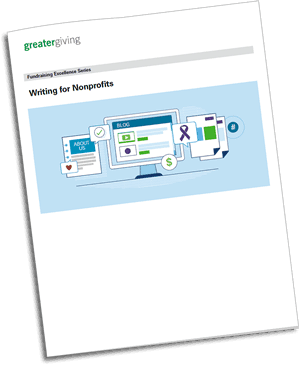

This post is the third in a series designed to teach the art and fundamentals of writing for nonprofits. These posts are based on the “Writing for Nonprofits” Guide from the Greater Giving Fundraising Excellence Series. Each new post focuses on an individual type of communication or relationship, and how best to tailor your writing to it. Read additional articles: Writing For Nonprofits Series
Your nonprofit is always out there doing great work. But no matter how small, any event, volunteer project, or routine activity could be a rich story waiting to be told. Everything you do is a story waiting to inspire your donors into giving more, or again, or for the first time. Sometimes it just takes the right story to speak to a new donor and get them involved.
 So how do you find these stories, craft them, and distribute them to encourage giving?
So how do you find these stories, craft them, and distribute them to encourage giving?Document and Collect Everything
Whenever you send out volunteers, send them with a complete photo and video directive. What I mean is that I want you, your staff, or your volunteers out there recording everything you do in the community; everything furthering your mission. You never know where you might find the perfect seed for a story.
So document all of your projects. Capture your beneficiaries in action, and show how your work helps them.
And ask questions while you’re out in the field to get ideas for stories you could tell. Do interviews with beneficiaries, volunteers, staff, and anyone else involved in your organization’s execution of its mission. Sometimes the right story will show itself when people start talking.
Keep a Multimedia Eye Out
 Social media is the perfect venue for sharing the small victories. Publishing simple, short stories, or progress updates on larger projects, helps to keep your community consistently engaged.
Social media is the perfect venue for sharing the small victories. Publishing simple, short stories, or progress updates on larger projects, helps to keep your community consistently engaged.
You’re always working toward your mission, so show off being in your community and making a difference as often as you can. Every engagement is an opportunity for a donation! And now you have plenty of photos to add to your posts.
Remember that videos are great for sharing stories, too. Getting some video footage is a great idea if you want to build a press kit someday. Videos are also excellent for social media sharing. You can tell a story quickly and engage more of your audience’s senses with video than with text or images. When supporters can see and hear it, your work will seem so much more real to them.
Don’t forget to take down paper notes during your interviews! These can be incredibly helpful in writing your campaign emails. Chat up volunteers, beneficiaries, and anyone else involved with your event or organization as you dig around for stories.
Key Elements of a Story
It sounds challenging to write a story yourself, but I promise that you have most of the ingredients already staring you right in the face. All you need to know are the actors, the problem, and the solution. Then use these three key steps to craft your story.
TIP
Think about your tone and your goals. Is this a funny story, an inspiring story, a sentimental story? Successful stories that have some of everything. A little humor and a lot of tugging on the heart strings, for example, can engage donors and put them in a giving mood.
- Establish a status quo. You need a main character, or small group of characters, to be your heroes—these could be your staff members and volunteers out in the field, doing their work, or someone your organization helped empower. Start by showing us things as they currently stand: some problem in need of solving, and a group positioned to solve it. (Hint: it’s your mission!)
- Why do we care about these heroes and want them to succeed? How are they like us? Give us details about them to make them sympathetic and relatable to your audience. E.g., these volunteers are just average people out there trying to make a difference.
- It’s key to give your heroes some kind of desire or goal. What are they here to do? Why is it important to them to achieve it?
- This is where your interviews of volunteers, staff, and other important actors at your organization are important. Ask questions to discover those compelling details that make a story or character really ring true.
- Something to fight for. Next, a story needs a conflict or quest. What obstacle or opponent stands in the way of your heroes achieving what they want?
- Your obstacle could be an abstract concept, like poverty or pet abandonment. Frame it as a villain that must be defeated. What are the consequences if the obstacle can’t be overcome? Establish the stakes in your story.
- How will your heroes face this challenge? What have you empowered them with? This is a great way to show where donors get involved. How have their contributions equipped your team with the tools they need to achieve?
- This is a great time to show how dire the stakes are, and what could happen should the heroes—your team—not succeed.
- Victory and resolution. This is where you give us the action, and the climax of the story. Show donors how your heroes have banded together and defeated the villain. How did your talented team overcome this crisis, accomplish its mission, or conquer the odds?
 This is a great time to show off those videos and photos of your mission: accomplished. Showcase your achievement.
This is a great time to show off those videos and photos of your mission: accomplished. Showcase your achievement.- In the same way you demonstrated the stakes to this story—what we stood to lose if the heroes failed—now it’s time to show the impact of that victory. How has this success altered the landscape and furthered the overall goals of your nonprofit? How have lives been changed? What are the long-term benefits of what you’ve done?
- End with a call to action. Donors have seen first-hand now how their donations matter and effect change. Call on them to take action (such as visiting a donation page) and make more missions a success in the future.
Sharing and Distributing Stories
How you embellish a story has a lot to do with the channel and medium you’re using to distribute it. In a Facebook post, you want to focus your energy on one main image or video. In an email, you have an opportunity to write a longer story and illustrate it with multiple photos.
Choose your story based on how much length you have to work with. Shape your story appropriately to your medium. Always focus on showing your donors’ their dollars at work. With each update, you’re giving proof of how important their continued support is, and how it accomplishes your shared mission every day.

